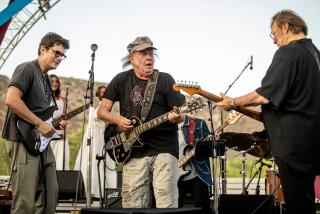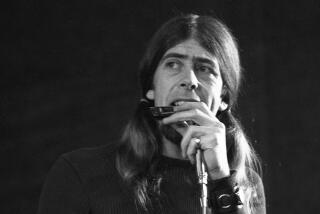Mature and Engaging, Jon Mayer Leaves the Past Behind
Pianist Jon Mayer’s performance at Steamers in Fullerton Saturday shed double light on his abilities: First he led a trio in instrumental numbers, then provided accompaniment for singer Stephanie Haynes. In both cases, he proved himself to be a musician of considerable technical facilities with a mature, engaging improvisational sense and an extreme sensitivity to the music going on around him.
Mayer, 58--who’ll make a couple more appearances in Orange County this week with a trio--is a product of New York’s fabled “uptown” scene of the ‘50s. Born a couple of blocks from Harlem’s Apollo Theatre, he attended New York’s High School of Music and Art and the Manhattan School of Music. Hands-on experience began at age 17 when he started to frequent Harlem’s Seventh Avenue clubs--Small’s Paradise, Count Basie’s, Connie’s and others--where he played jam sessions with the likes of Wayne Shorter, Joe Farrell and Larry Gales.
He soon gained a reputation as a prodigy and sat in with such well-known performers as Art Blakey, Chet Baker, Max Roach and Kenny Dorham. Before he was 20, he had recorded with Jackie McLean on McLean’s “Strange Blues” album (reissued on Original Jazz Classics) and with John Coltrane on Ray Draper’s Roulette release “Like Sonny” (later released under Coltrane’s name). Mayer went on to work with the Thad Jones-Mel Lewis Orchestra, Kai Winding, Sarah Vaughn, Dionne Warwick and Manhattan Transfer.
But the rigors of a life in jazz took their toll and in 1976, shortly after his first tour with the Transfer, he disappeared from the scene. He resurfaced in 1991 in Los Angeles, where he has enjoyed a close association with fellow pianist Les McCann.
His appearance at Steamers revealed that his style has evolved with the times, from his early bebop to a more modern, hard-bop sound of the sort heard from McCoy Tyner, Herbie Hancock and Kenny Barron. His opening number, “Tragic Magic” (a Barron composition), was a thoroughly modern affair with a bouncy, to-the-point theme followed by involved improvisation.
Mayer’s solo took on narrative airs as long, swirling phrases alternated with clipped bursts of punctuation and empty space that allowed the lines to sink into memory. Loudly played series of chords came before quiet, whispered passages, another technique that served to draw in the audience. His closing lines of “Never Let Me Go” corkscrewed into deep registers before concluding in hushed chords. “Falling in Love” was played with a Latin feel and a percussive manner.
Unlike many pianists, when it came time to support a singer, Mayer didn’t change his delivery much. He was reserved during “You’d Be So Nice to Come Home To.” For “Detour Ahead,” he jumped into his solo with a series of whippoorwill chirps before moving into more involved lines. As Haynes increased her dynamic level during the lament “Down Here on the Ground,” Mayer was right there with her, shoveling louder and hotter chords beneath her building fire.
Backed by bassist Darek Oles and drummer Paul Kreibich, a fine rhythm team, Mayer showed a responsive side, taking cues from Oles’ lyrical way with a walk and sometimes echoing a snare-and-tom exchange from Kreibich with high-low phrases of his own.
This week Mayer will be joined by bassist Luther Hughes and drummer Roy McCurdy, a veteran of Cannonball Adderly’s and Sonny Rollins’ groups. His 15-year hiatus well behind him now, Mayer can stand as an example of one who has settled in for the long haul of a lifetime in jazz.
* The Jon Mayer Trio plays Tuesday at 7:30 p.m. at Spaghettini, 3005 Old Ranch Parkway, Seal Beach (no cover. [562] 596-2199) and Wednesday at 7 p.m. at Steamers Cafe, 138 W. Commonwealth Ave., Fullerton (no cover. [714] 871-8800.)
More to Read
The biggest entertainment stories
Get our big stories about Hollywood, film, television, music, arts, culture and more right in your inbox as soon as they publish.
You may occasionally receive promotional content from the Los Angeles Times.










